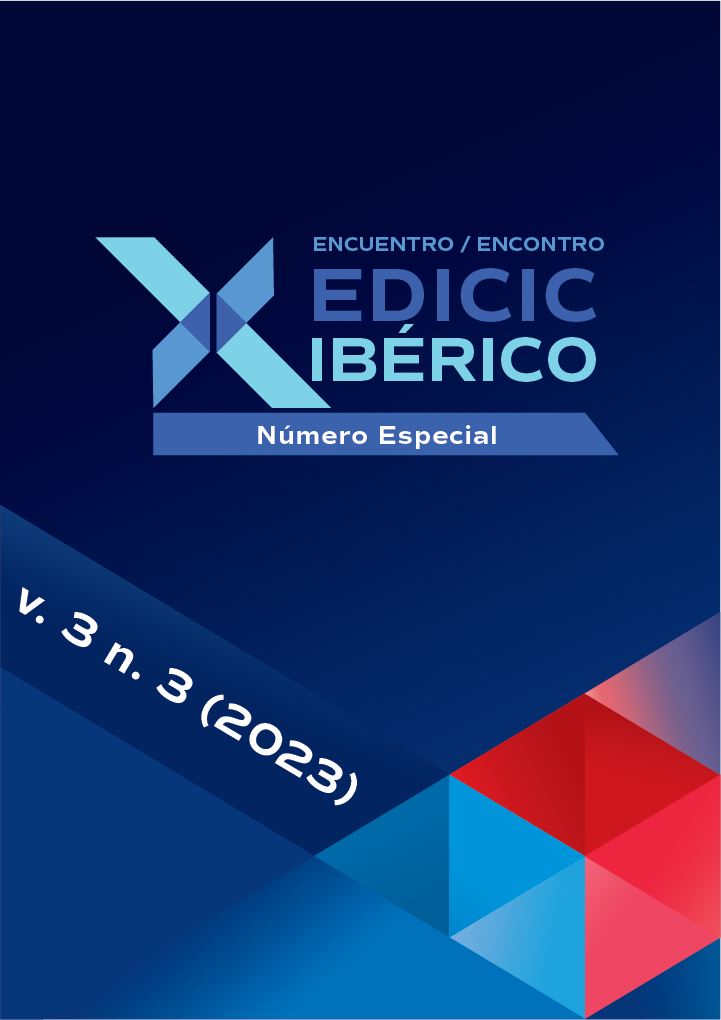Comportamento informacional estereotipado causado pelas mídias sociais: um estudo de caso do tiktok
DOI:
https://doi.org/10.62758/re.v3i3.235Palavras-chave:
Comportamento Informacional Estereotipado, Bolhas de Filtro, Câmaras de Eco, Mídias Sociais, TikTokResumo
Este estudo aprofunda o fenômeno do comportamento de informação estereotipada no âmbito das redes sociais, com foco específico na plataforma TikTok. Utilizando uma abordagem multimétodo, nosso objetivo é desvendar as dinâmicas intrincadas envolvidas quando os usuários interagem com conteúdo que pode reforçar crenças e estereótipos existentes. A prevalência e a natureza multifacetada do comportamento de informação estereotipada são iluminadas por meio de uma análise abrangente das interações dos usuários no TikTok. Nossas descobertas revelam um padrão convincente: os usuários mostram uma tendência a interagir com conteúdo que está alinhado com suas crenças preexistentes. Uma característica distintiva do TikTok é seu formato centrado no visual, caracterizado por vídeos curtos e envolventes. Este aspecto amplifica o potencial para o reforço de estereótipos. Imagens e memes, em particular, emergem como ferramentas poderosas para a disseminação de informações precisas e enviesadas. Além disso, nossa pesquisa lança luz sobre a formação de bolhas de filtro e câmaras de eco dentro do ecossistema do TikTok. Os usuários tendem a estar imersos em conteúdo e interações que reafirmam suas crenças existentes, limitando potencialmente a exposição a perspectivas diversas. Esse fenômeno reflete observações em outras plataformas de redes sociais e destaca a necessidade de estratégias para promover um ambiente de informação mais inclusivo. Esta pesquisa destaca a necessidade urgente de continuar investigando como as plataformas de redes sociais influenciam o consumo e o processamento de informações. À medida que essas plataformas continuam a moldar o discurso público, é imperativo que os usuários, criadores de conteúdo e desenvolvedores de plataformas permaneçam vigilantes em seus esforços para mitigar a possível perpetuação de estereótipos.
Referências
Arendt, F. (2023). Media stereotypes, prejudice, and preference-based reinforcement: Toward the dynamic of self-reinforcing effects by integrating audience selectivity. https://doi.org/10.1093/joc/jqad019. DOI: https://doi.org/10.1093/joc/jqad019
Augoustinos, M., & Walker, I. (1998). The Construction of Stereotypes within Social Psychology: From Social Cognition to Ideology. Theory & Psychology, 8(5), 629–652. https://doi.org/10.1177/0959354398085003. DOI: https://doi.org/10.1177/0959354398085003
Beeghly, E. (2015). What is a Stereotype? What is Stereotyping? Hypatia, 30(4), 675–691. https://doi.org/10.1111/hypa.12170. DOI: https://doi.org/10.1111/hypa.12170
Bosco, C., Patti, V., Frenda, S., Cignarella, A. T., Paciello, M., & D’Errico, F. (2023). Detecting racial stereotypes: An Italian social media corpus where psychology meets NLP. Information Processing & Management, 60(1), 103118. https://doi.org/10.1016/j.ipm.2022.103118. DOI: https://doi.org/10.1016/j.ipm.2022.103118
Bruns, A. (2019). Filter bubble. Internet Policy Review, 8(4). https://policyreview.info/concepts/filter-bubble. DOI: https://doi.org/10.14763/2019.4.1426
Cinelli, M., De Francisci Morales, G., Galeazzi, A., Quattrociocchi, W., & Starnini, M. (2021). The echo chamber effect on social media. Proceedings of the National Academy of Sciences, 118(9), e2023301118. https://doi.org/10.1073/pnas.2023301118. DOI: https://doi.org/10.1073/pnas.2023301118
Clark, C. J., & Winegard, B. M. (2020). Tribalism in War and Peace: The Nature and Evolution of Ideological Epistemology and Its Significance for Modern Social Science. Psychological Inquiry, 31(1), 1–22. https://doi.org/10.1080/1047840X.2020.1721233. DOI: https://doi.org/10.1080/1047840X.2020.1721233
Dandekar, P., Goel, A., & Lee, D. T. (2013). Biased assimilation, homophily, and the dynamics of polarization. Proceedings of the National Academy of Sciences, 110(15), 5791–5796. https://doi.org/10.1073/pnas.1217220110. DOI: https://doi.org/10.1073/pnas.1217220110
Davies, H. (2018). Redefining filter bubbles as (escapable) socio-technical recursion. Sociological Research Online, 23(3). https://ora.ox.ac.uk/objects/uuid:c78b6c16-0d9a-44f9-986a-ba4343fa384c.
Ditto, P. H., Liu, B. S., Clark, C. J., Wojcik, S. P., Chen, E. E., Grady, R. H., Celniker, J. B., & Zinger, J. F. (2019). At Least Bias Is Bipartisan: A Meta-Analytic Comparison of Partisan Bias in Liberals and Conservatives. Perspectives on Psychological Science, 14(2), 273–291. https://doi.org/10.1177/1745691617746796. DOI: https://doi.org/10.1177/1745691617746796
Dobson, K., & Knezevic, I. (2018). “Ain’t Nobody Got Time for That!”: Framing and Stereotyping in Legacy and Social Media. Canadian Journal of Communication, 43(3), 381–397. https://doi.org/10.22230/cjc.2018v43n3a3378. DOI: https://doi.org/10.22230/cjc.2019v44n3a3378
Döring, N., Reif, A., & Poeschl, S. (2016). How gender-stereotypical are selfies? A content analysis and comparison with magazine adverts. Computers in Human Behavior, 55, 955–962. https://doi.org/10.1016/j.chb.2015.10.001. DOI: https://doi.org/10.1016/j.chb.2015.10.001
Fosch-Villaronga, E., Poulsen, A., Søraa, R. A., & Custers, B. H. M. (2021). A little bird told me your gender: Gender inferences in social media. Information Processing & Management, 58(3), 102541. https://doi.org/10.1016/j.ipm.2021.102541. DOI: https://doi.org/10.1016/j.ipm.2021.102541
Gouvernement du Québec. (n.d.). Effects of Stereotypes on Personal Development. Retrieved August 13, 2023, from https://www.quebec.ca/en/family-and-support-for-individuals/childhood/child-development/effects-stereotypes-personal-development/definition-stereotypes.
Green, C. (2015, October 15). What are the causes of stereotypes? Getting Race Right. https://blogs.hope.edu/getting-race-right/our-context-where-we-are/the-history-we-inhaled/what-are-the-causes-of-stereotypes/.
Hamilton, D. L. (2015). Cognitive Processes in Stereotyping and Intergroup Behavior. Psychology Press. DOI: https://doi.org/10.4324/9781315668758
Haner, M., Sloan, M. M., Pickett, J. T., & Cullen, F. T. (2020). Safe haven or dangerous place? Stereotype amplification and Americans’ perceived risk of terrorism, violent street crime, and mass shootings. The British Journal of Criminology, 60(6), 1606–1626. DOI: https://doi.org/10.1093/bjc/azaa045
Huber, B., & Baena, L. Q. (2023). Women Scientists on TikTok: New Opportunities to Become Visible and Challenge Gender Stereotypes. Media and Communication, 11(1), 240–251. https://doi.org/10.17645/mac.v11i1.6070. DOI: https://doi.org/10.17645/mac.v11i1.6070
Institut für Sozialarbeit und Sozialpädagogik e.V. Agency. (2022). Fact Sheet 6: Gender stereotypes on social media. Institut für Sozialarbeit und Sozialpädagogik e.V. Agency.
Intravia, J., & Pickett, J. T. (2019). Stereotyping Online? Internet News, Social Media, and the Racial Typification of Crime. Sociological Forum, 34(3), 616–642. https://doi.org/10.1111/socf.12515. DOI: https://doi.org/10.1111/socf.12515
Jones, M., & Sugden, R. (2001). Positive confirmation bias in the acquisition of information. Theory and Decision, 50(1), 59–99. https://doi.org/10.1023/A:1005296023424. DOI: https://doi.org/10.1023/A:1005296023424
Jr, R. S. W., & Srull, T. K. (2014). Handbook of Social Cognition: Volume 2: Applications. Psychology Press.
Kappes, A., Harvey, A. H., Lohrenz, T., Montague, P. R., & Sharot, T. (2020). Confirmation bias in the utilization of others’ opinion strength. Nature Neuroscience, 23(1), Article 1. https://doi.org/10.1038/s41593-019-0549-2. DOI: https://doi.org/10.1038/s41593-019-0549-2
Liu, J. (2021). The Influence of the Body Image Presented Through TikTok Trend-Videos and Its Possible Reasons. 359–363. https://doi.org/10.2991/assehr.k.210609.072. DOI: https://doi.org/10.2991/assehr.k.210609.072
Macrae, C. N., Milne, A. B., & Bodenhausen, G. V. (1994). Stereotypes as Energy-Saving Devices: A Peek Inside the Cognitive Toolbox. Journal of Personality and Social Psychology, 66(1), 37–47. https://doi.org/10.1037/0022-3514.66.1.37. DOI: https://doi.org/10.1037//0022-3514.66.1.37
Maftei, A., & Merlici, I.-A. (2022). Am I thin enough? Social media use and the ideal body stereotype: The mediating role of perceived socio-cultural pressure and the moderating role of cognitive fusion. Current Psychology. https://doi.org/10.1007/s12144-022-02938-x. DOI: https://doi.org/10.1007/s12144-022-02938-x
Matamoros Fernandez, A., Rodriguez, A., & Wikstrom, P. (2022). Humor That Harms? Examining Racist Audio-Visual Memetic Media on TikTok During Covid-19. Media and Communication, 10(2), Article 2. DOI: https://doi.org/10.17645/mac.v10i2.5154
McGregor, S. C. (2019). Social media as public opinion: How journalists use social media to represent public opinion. Journalism, 20(8), 1070–1086. https://doi.org/10.1177/1464884919845458. DOI: https://doi.org/10.1177/1464884919845458
Min, S. J., & Wohn, D. Y. (2020). Underneath the Filter Bubble: The Role of Weak Ties and Network Cultural Diversity in Cross-Cutting Exposure to Disagreements on Social Media. The Journal of Social Media in Society, 9(1), Article 1.
Min, Y., Jiang, T., Jin, C., Li, Q., & Jin, X. (2019). Endogenetic structure of filter bubble in social networks. Royal Society Open Science, 6(11), 190868. https://doi.org/10.1098/rsos.190868. DOI: https://doi.org/10.1098/rsos.190868
Munro, G., & Ditto, P. (1997). Biased Assimilation, Attitude Polarization, and Affect in Reactions to Stereotype-Relevant Scientific Information. Personality and Social Psychology Bulletin, 23, 636–653. https://doi.org/10.1177/0146167297236007. DOI: https://doi.org/10.1177/0146167297236007
Ng, R., & Indran, N. (2023). Videos about older adults on TikTok. PLOS ONE, 18(8), e0285987. https://doi.org/10.1371/journal.pone.0285987. DOI: https://doi.org/10.1371/journal.pone.0285987
Nickerson, R. S. (1998). Confirmation Bias: A Ubiquitous Phenomenon in Many Guises. Review of General Psychology, 2(2), 175–220. https://doi.org/10.1037/1089-2680.2.2.175. DOI: https://doi.org/10.1037//1089-2680.2.2.175
Pariser, E. (2011). The filter bubble: How the new personalized web is changing what we read and how we think. Penguin.
Quillian, L., & Pager, D. (2010). Estimating Risk: Stereotype Amplification and the Perceived Risk of Criminal Victimization. Social Psychology Quarterly, 73(1), 79–104. https://doi.org/10.1177/0190272509360763. DOI: https://doi.org/10.1177/0190272509360763
Rader, E., & Gray, R. (2015). Understanding user beliefs about algorithmic curation in the Facebook news feed. Proceedings of the 33rd Annual ACM Conference on Human Factors in Computing Systems, 173–182. DOI: https://doi.org/10.1145/2702123.2702174
Schmidt, A. L., Zollo, F., Del Vicario, M., Bessi, A., Scala, A., Caldarelli, G., Stanley, H. E., & Quattrociocchi, W. (2017). Anatomy of news consumption on Facebook. Proceedings of the National Academy of Sciences, 114(12), 3035–3039. https://doi.org/10.1073/pnas.1617052114. DOI: https://doi.org/10.1073/pnas.1617052114
Seiter, E. (2006). Stereotypes and the Media: A Re-Evaluation. Journal of Communication, 36, 14–26. https://doi.org/10.1111/j.1460-2466.1986.tb01420.x. DOI: https://doi.org/10.1111/j.1460-2466.1986.tb01420.x
Stangor, C. (1988). Stereotype Accessibility and Information Processing. Personality and Social Psychology Bulletin, 14(4), 694–708. https://doi.org/10.1177/0146167288144005. DOI: https://doi.org/10.1177/0146167288144005
Stephan, W. G. (1989). A Cognitive Approach to Stereotyping. In D. Bar-Tal, C. F. Graumann, A. W. Kruglanski, & W. Stroebe (Eds.), Stereotyping and Prejudice: Changing Conceptions (pp. 37–57). Springer. https://doi.org/10.1007/978-1-4612-3582-8_2. DOI: https://doi.org/10.1007/978-1-4612-3582-8_2
TikTok: Creative Center. (n.d.). Creative Center: One-stop creative solution for TikTok. Retrieved August 30, 2023, from https://ads.tiktok.com/business/creativecenter.
Turner, P., & Turner, S. (2011). Is stereotyping inevitable when designing with personas? Design Studies, 32(1), 30–44. https://doi.org/10.1016/j.destud.2010.06.002 DOI: https://doi.org/10.1016/j.destud.2010.06.002
Unni, Z., & Weinstein, E. (2021). Shelter in Place, Connect Online: Trending TikTok Content During the Early Days of the U.S. COVID-19 Pandemic. Journal of Adolescent Health, 68(5), 863–868. https://doi.org/10.1016/j.jadohealth.2021.02.012. DOI: https://doi.org/10.1016/j.jadohealth.2021.02.012
Xu, W. (2022). (Non-)Stereotypical representations of older people in Swedish authority-managed social media. Ageing & Society, 42(3), 719–740. https://doi.org/10.1017/S0144686X20001075. DOI: https://doi.org/10.1017/S0144686X20001075
Yuen, N. W. (2019, June 4). How Racial Stereotypes in Popular Media Affect People—And What Hollywood Can Do to Become More Inclusive. Scholars Strategy Network. https://scholars.org/contribution/how-racial-stereotypes-popular-media-affect-people-and-what-hollywood-can-do-become.
Downloads
Publicado
Como Citar
Edição
Seção
Licença
Copyright (c) 2023 Revista EDICIC

Este trabalho está licenciado sob uma licença Creative Commons Attribution 4.0 International License.
A Associação detém os direitos autorais dos textos que publica e adota a licença Creative Commons, CC BY 4.0 DEED Atribuição 4.0 Internacional (https://creativecommons.org/
Você tem o direito de:
- Compartilhar: copiar e redistribuir o material em qualquer suporte ou formato para qualquer fim, mesmo que comercial.
- Adaptar: remixar, transformar, e criar a partir do material para qualquer fim, mesmo que comercial.






